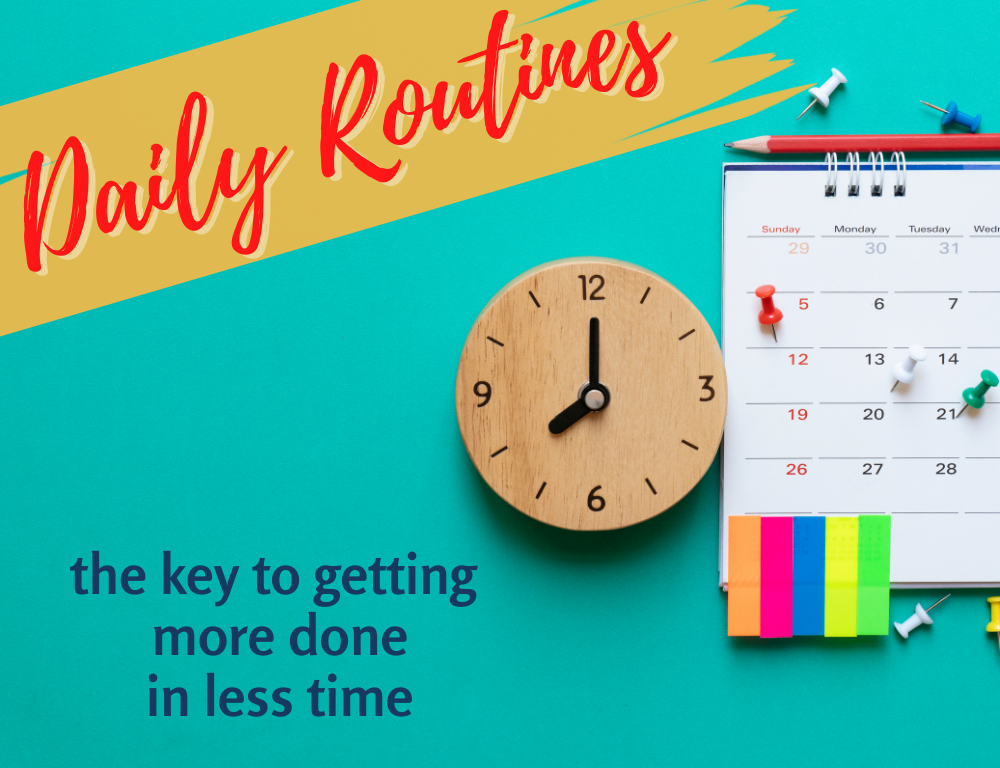It’s Saturday morning. You are about to start doing a few chores. Then the phone rings, the kids need help, the animals need to be let out. Before you know it over 30 minutes are gone and you didn’t even have enough time to get out the vacuum! How is it that everyone gets the same 24 hours, but I can’t seem to get anything done?Is there a way to STOP wasting time and energy making tasks harder than they need to be? How do I STOP re-creating the wheel every week?
The answer is to START building routines.

I get it! You hear the word routine, you think boring or restrictive. But don’t poo-poo this concept so quickly. Keep reading!
Definition of routine: a regular way of doing things in a particular order.
And yes, that does sound a little boring, but there is power in routines. As you build and practice your routines, you are programming your mind and body to do things in a particular order over & over to the point they become automatic. When your mind and body do things automatically, you are saving energy that you were using to think about doing these tasks. With that saved energy you start to become more efficient doing the tasks, which saves you precious time!
With that time & energy you are saving by building routines, you may also start to notice other benefits like:
- Becoming more productive in other areas of your life because you’re not wiped out by doing the easy things.
- Ablity to focus your attention on more important or difficult things because you’ve freed up your mind from the boring, mundane tasks.
- Prioritizing other demands becomes easier and less stressful.
- Developing confidence that you are in control of your life and not the other way around.
- Experiencing decreased amounts of stress and anxiety
Are you on board and ready to start building your routines? Yes!!
START by setting aside 30 min to 1 hour of uninterrupted time to work on this exercise to outline your daily habits.
Step #1 – List out all the tasks you need to do regularly. Don’t just limit to think weekly daily, but also, monthly, yearly. I mean EVERY TASK. (You can download a template for this above!)
Step #2 – Go thru the list and note how frequent task needs to be completed
D = Daily
W = Weekly
M = Monthly
Y = Yearly
O = Other
Step #3 – Think of your day in blocks of time that are minimum an hour. Designating a block of time to doing tasks allows for more tasks bundled together (or a routine!).
Start with 3-4 blocks of time for routines
- Morning
- Mid-Day
- Evening
- Bedtime
Step #4 – Use the Task List above and specifically the tasks identifed as DAILY and designate these tasks to be completed in one of the 4 routine blocks. Decide which time block works best for you and that task depending on the brain power or level of physical effort needed.
When you assign a task to a time block, also assign a rough amount of time needed to complete the task.
Step #5 – Keep track for 1 week.
- Check off every time you have completed the task for each daily column. Make notes through the week. Did you do more in the time block than you planned? What tasks did you add?
- Reflect – Could you tell a difference in your productivity this week? Did having this list, a plan, reduce stress for you?
- Plan for next week. Make a copy of the checklist taking in to account your notes.
Step #6 – Keep working on your daily routines for the next several weeks.
You should start to notice that you are doing the tasks without having to refer to the checklist. As you are working to build routines it is a good idea to be CONSISTENT in your wake and sleep times every day of the week. This creates repetition and gets those routines to “stick” faster than if you have different schedules on your off days.







